Menus
- The ideal compromise between 125 and bigger maxi-scoot
- Test over 2 weeks and 1,000 kilometers
- Discovery
- In the saddle
- Contact
- In the city
- On the highway
- Braking
- Duo
- Consumption
- Convenient
- Conclusion
- Suzuki Burgman 400 video test
The ideal compromise between 125 and bigger maxi-scoot
Test over 2 weeks and 1,000 kilometers
1998! Almost twenty years since the Suzuki Burgman 400 was launched, the first of a new category called maxi-scooter. After the 125, we would finally be able to discover the sensations of a large engine with the utility advantages of a scooter in terms of storage and protection.. If the category has attracted many countries including Italy, it has remained the poor relation of maxi-scooters in France, far behind the 500 cm3 and more, despite 11,615 models sold in France for the 400. Past history? Can the new Burgman 400 be a game-changer? Test…

Discovery
The Burgman 400 from 1998 and then from 2006 were big brothers of the Burgman 125 version, more than little brothers of the Burgman 650 version. And that was good news: a small size guaranteeing agility and dynamics with yet a big engine. The recipe does not change in 2017 and is even accentuated. Because the Burgman 400 has undergone a dry regime, both in terms of the general line, finer and more sporty, than in weight with seven kilos less.

More sporty! This is perhaps the key word for this 2017 vintage against a traditionally GT urban scooter. The refined lines and a seemingly narrower cockpit really give the impression of being on a 125. In fact, the Burgman has lost its bulges to gain lightness, while still remaining plush and GT. The passenger seat has been lowered, confirming the impression of a smaller model. But it also benefits from the latest developments with LED light signature at the front and LED tail light, but also new indicators such as the Eco driving indicator discovered a few years ago on the 650. The screen is straighter and apparently lower.
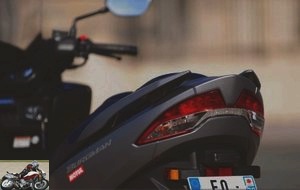
Afterwards, there are small finishing details, which catch the eye like the double stitching of the saddle, the saddle itself more padded.
Behind these cosmetic changes hides a new scooter, including a completely new frame for more rigidity. Since you don’t change a reliable engine, the 399cc single-cylinder hasn’t really changed, except for the fact that it gains a larger airbox and new settings that give it more torque at low and mid-range. at the expense of maximum speed.
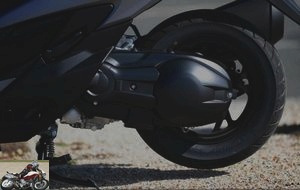
But the major change remains the front wheel which goes to 15 inches, offering more stability. Finally, the suspensions have been reworked to offer more comfort.
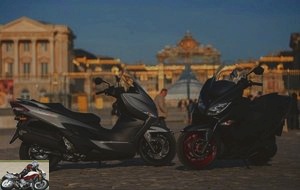
Finally, entirely made in Japan, it does not suffer from any apparent quality defect..
In the saddle
Despite a higher saddle, the 1.70 rider still puts his feet flat, thanks to a thinner saddle and a new notch in the step. Smaller riders will appreciate many models on the market, including 125, where you barely put your toes. The feet are flat, this significantly facilitates parking maneuvers in town. The weight naturally has nothing to do with the 650 and you don’t feel it, hardly giving the impression of heavier than a 125.
The position with a higher saddle is a little more upright than before and at first nevertheless gives the impression of having the arms noticeably raised, a feeling that disappears after a few kilometers..
The dashboard has evolved to be more modern, losing some analog meters to enlarge the digital part. The overall impression is better and more modern compared to an old "car" dashboard..
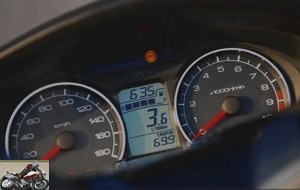
Contact
The Burgman snorts with a thud. He will not risk waking the neighbors in the middle of the night. The reaction to the right grip is still as lively and does not at any time give the impression of heaviness that some maxi-scooters can give on the first turns of the wheel..
In the city
The old model was already manoeuvrable in town. It hasn’t changed. With 5mm more width, at most it gives the impression of passing more easily between the lines of the car. On the other hand, we feel the improvement in torque at low and mid-range, with a more dynamic engine, which makes it possible to extract and navigate more easily in the flow of traffic. And conversely, the 17-inch wheel brings more stability with a healthier front steering which makes the city pleasant..
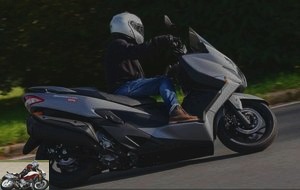
But it is its engine approval that makes it pleasant with a smoothness that is quite rare in the segment, smoothness not being the opposite of dynamics, very real also if necessary and which only waits for a request from the throttle..
On the highway
The Burgman 400 sets off quickly on the motorway to stabilize at 140 km / h then gradually gains a few km / h, to oscillate between 143 and 145 km / h meter. What has been gained in urban areas with more efficient behavior and pickups at mid-speed is lost a little at high speed. However, it is a single cylinder and it was not yet run in. The test will therefore be repeated after a model of more than 1000 km, because there is only one kw of lost at high speed and it would be surprising to lose more than 10 km / h compared to the old model which was particularly fast on the motorway for the category.
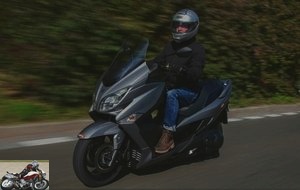
Braking
The Burgman 400 now benefits from ABS, intrusive limit if one uses only the rear brake by triggering quite easily with lifts in the left handle. On the other hand, the front brake is not at all, to such an extent that the front tire screeches under sustained braking, therefore at the maximum limit of grip! Emergency braking with only the front brake is very effective. And the grip of the two handles is more than enough with the disc 260 at the front and 210 at the rear to stop in all conditions, even extreme..
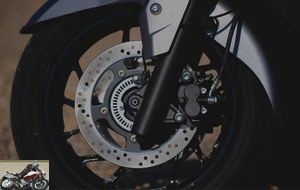
Duo
The weak point of the old vintage was based on the duo, with a noticeable sway effect, unpleasant in town. The lower passenger saddle and a more dynamic engine at low speed, limit this effect, without making it completely disappear, especially on the interface at very low speed (less than 5 km / h) especially in Paris. We feel the tension then on the arms in duet compared to driving solo. On the other hand, the duet covers are better than the old one, making its daily use as a duet more pleasant..
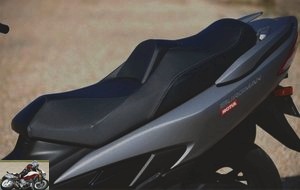
Consumption
Suzuki has worked a lot on the consumption of the Burgman 400 whose consumption has officially gained 0.5 liters better per hundred kilometers. The test first allowed us to note an average consumption of 3.5 per cent according to the on-board computer, which would allow a range of nearly 400 kilometers. Problem, the on-board computer is optimistic and the reserve warning light came on from 220 km. And we put 11 liters at 240 km, which therefore makes an average consumption of 4.5 liters, allowing a real range of 300km with the 13.5 liters of the tank. On the other hand, as it is a 400 and not a 250 (or even a 125), we do not need to start knocking to go quickly and suddenly, even without needing to be careful, we do not consume more in the end, except in duo where we noted a slight increase of 0.2 l / 100.
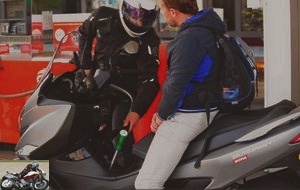
Convenient
There were three front pockets, there are now only two. On the other hand, they are particularly deep with a capacity of 4.2 liters and 5 liters, with an additional cigarette lighter socket on the left allowing you to charge even the largest smartphones on board..
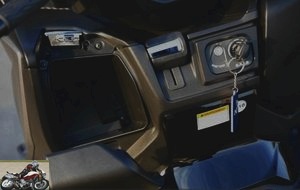
On the other hand, surprisingly, the trunk lost twenty liters, going from 62 to 42 liters! We put two modulars. We only put one with an extra throw. What the scooter has gained in line and in weight, it has unfortunately also lost in boarding capacity.
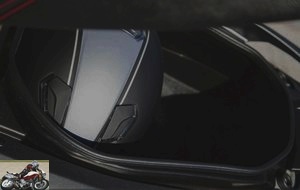
It retains its two crutches, lateral and central, with a central relatively easy to set up.
It also retains the parking brake, now in the center, easy to set and release and reassuring when parked on the side.
The Neiman still benefits from its mechanical protection, unlockable with the back of the key.
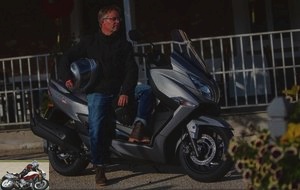
Conclusion
Even lighter (-7kg), more manoeuvrable but therefore more stable, the Burgman 400 returns to the front of the stage with a line in the era of time and a truly modern model. The 400 cm3 displacement, little known, remains by far the best compromise between the 125 and the very large maxi-scoots, often too big for the city and above all much more expensive.. . .
Strong points
- motor
- maneuverability
Weak points
- recessed trunk capacity
- price
Burgman 400 technical sheet
Test conditions
- Itinerary: town + small varied roads + motorway
Suzuki Burgman 400 video test
Related articles
-
Suzuki DL 650 VStrom motorcycle test – 2012 vintage
Aids for the road 10 years of good and loyal service … the DL 650 VStrom indeed celebrates a nice anniversary in 2012, without having succeeded in…
-
2013: Always more Pullman with standard options 11 years old! It took 11 years and more than 83,000 units sold worldwide for Suzuki to upgrade its famous…
-
Mouse of the cities and the fields If Suzuki was the first manufacturer to launch the largest of the scooters with the Burgman 650, declined with the 125…
-
Executive power BOBO In the Burgman family, I want…. the 125! The 125 is the smallest of the Suzuki scooters, but shares with its brothers an identical…
-
The Burgman is the line of Suzuki scooters, available in 125, 200, 400 and 650 cm3. The 400 version is aesthetically very close to the 125 version, and a…
-
On the cobblestones, the Van Van the Van Van is the surprise of the year 2002: a strange machine trendy reminiscent of Dax and other UFOs, resurgence of…
-
The mid-size trail passes Euro 4 standards: 645 cm3, 71 hp and 62 Nm, 216 kilos, € 8,899 A simple, accessible, versatile and efficient motorcycle For 7…
-
GSR reloaded Appeared in 2011, the GSR 750 hands over to the GSX-S 750, an heiress who wants to reshuffle the cards in a category in perpetual movement…
-
Suzuki Bandit 650 S motorcycle test
Released for good behavior 1500 km test Pioneer of the nasty roadster, the Bandit evolves in displacement to celebrate its 10th anniversary, for a 650…
-
Suzuki Bandit 1250 N GSF motorcycle test
The Suzuki Bandit 1250 is the evolution of the Bandit 1200, the big historic roadster unveiled in 1995, having hit sales not only for its puncture-proof…
I put the comment here instead…
I really like these tires. I drive in ER6F, I had Roadsmart II (original equipment) then Pilot Road 3. I had a band of fear at the back of approximately 1cm. When I switched to PP3, I felt a big difference, my bike seemed different to me. They have incredible grip and quickly put you in confidence. As soon as the tires were broken in, I no longer had any fear band at the rear, without forcing, simply because I was more confident on the bike..
I ride every day, so I had the opportunity to try them out in the rain! They still hang very well, even if the fact that the edges are without sculptures remains in mind and prevents taking too much angle (I think that’s pretty good, by the way wink). I did some in-line brake testing in the wet, and it was difficult to trigger the ABS, so they hold up pretty well..
I had a scare one day when it was raining and it was cold this winter, they stalled on exiting the turn, on the go-around, and the motorbike did well … kicking in both ankles (kicks ) anyway! But I stayed on it.
In terms of grip, you can feel when they are going to stall, and when they slip a little, which happens under certain conditions. I don’t have a bigger description of these conditions, it is quite variable, but always it feels when they start to go wrong.
The white bands are not their friends, even when the weather is good. But no drama, the white stripes are not my friends either.
In terms of wear, they tend to wear more on the edges than in the middle (front and back), but I ride on roads where there are a lot of bends (even in my home-work trip).
Lifetime ? I did 6000km with the first two PP3s mounted at the back, each time with a track session – where they worked well (see below). The front tire is more like 8000km with two track sessions. With the roadsmart II (original equipment) or the PR3, I was rather doing 6500 and 8500km on the rear tire.
Rear after track:
[attachment 18373 1276588_629458123761128_1571377199_o.jpg]
Before after track:
[attachment 18374 1294282_629458273761113_1241021370_o.jpg]
In road use, the front tire has almost 8000 km – I have circled the wear indicators
[attachment 18375 tireav8000.jpg]
I’m on the third climb, on a B King full.
Longer life than others
Handling in the dry = 10/10 like many other brands
Handling in the wet = 10/10 I’m still here
longevity = greater than other brands = 10 to 15% / km
Price = A little cheaper than others (novelty ????)
Conclusion for me: no need to make a page.